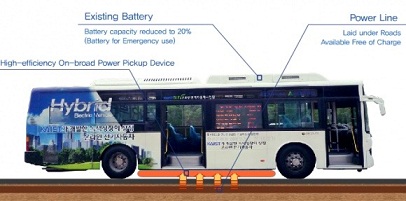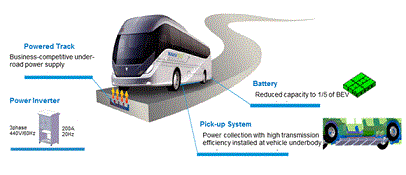Online Electric Vehicle (OLEV) is an electric vehicle with electromagnetic induction. 9 March 2010 investigators from The Korea Advanced Institute of Science and Technology (KAIST) initiate a public transport system using a "recharging road". Electric power strips have been obscured 30 cm (11.8 in) under the road surface also connected to the national grid. Underneath the vehicle there is Pick-up equipment which then collects power from non-contact magnetic induction which is used to power the vehicle prime-mover or for charging of battery. Demonstration system is a trackless train with an electric tractor hauling three passenger cars.

The world's first wireless electric bus developed by KAIST is Gumi which is in operation from July 2013. Electricity is wirelessly fed into the bus from the tracks.
Two OLEV buses will run an inner city route between Gumi Train Station for a total of 24 km roundtrip. The bus will receive 20 kHz and 100 kW (136 horsepower) electricity at an 85% maximum power transmission efficiency rate while maintaining a 17cm air gap between the underbody of the vehicle and the road surface.
OLEV is a groundbreaking technology that accelerates the development of purely electric vehicles as a viable option for future transportation systems, be they personal vehicles also public transport. This is accomplished by solving technological issues that limit the commercialization of electric vehicles such as volume, weight, driving distance, price and lack of charging infrastructure.
Working of Online Electric vehicles (OLEV):
It sounds different that a vehicle runs on electricity which takes its power from the road, whereas there is no sign of electrical wire on the road surface. This is how it seems to work at first glance. Online electric vehicles (OLEV) run on recharging road that denotes to the strips of road underneath which electric power strips are spread and the vehicle while moving over the road surface just connects to power through magnetic induction. This method is more like trackless train with number of passenger cars moving behind the tractor that takes the power from road. As per the historical accounts of similar technology that previously been launched in other parts of the globe OLEV differs in number of aspects than the earlier versions of technology. Most important of these differences is the security aspect. In prior experiments the magnetic induction sometimes proved to be harmful to the passengers and on-board people because of electromagnetic waves. OLEV could successfully address the safety issues by properly providing shield from the magnetic induction system.
Future and its Benefits:

In terms of vehicle price OLEV is highly cost effective, economical energy cost and reasonable infrastructure costs. Prior occupation of convergence technology and reduction in the burden of oil demand and supply. As a result of improved battery capacity and cheap costs. New market opportunities are produced also the spread of electric vehicles is accelerated in the global market.
The spread of electric vehicles leads to a decrease in oil consumption and helps reduce. As a result of decreased CO2 emissions, the obligations under the Convention on Climate. Change can be met and CDM effects are generated.
This typical wireless technology of feeding a vehicle its required electricity for producing kinetic energy is revolutionary in many respects and benefits are massive. Alternate source of power use in transport vehicles will definitely have some restoring effect on the world's decreasing energy level and fast eradicating nature. Secondly being zero emission vehicle it will be least polluting to the environment. Thirdly as Online electric vehicles (OLEV) run on electricity it is definitely going to be cheaper when it becomes the main mode of public transport.
It seems like every week there's a new scheme for making electric vehicles a reliable transportation option for masses but team of South Koreans at Korea Advanced Institute of Science and Technology (KAIST) launched what may be one of the most feasible plans we've seen. The Online Electric Vehicle (OLEV) gathers power magnetically from electric strips buried below the road's surface as it travels, eradicating the requirement for long-term recharging.